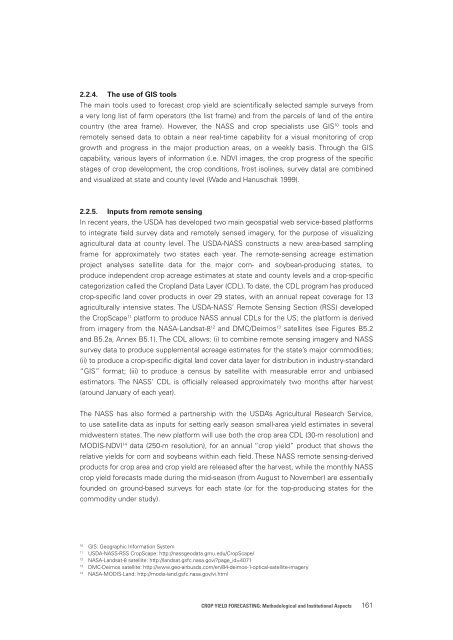Crop Yield Forecasting
1qKZxmS
1qKZxmS
Create successful ePaper yourself
Turn your PDF publications into a flip-book with our unique Google optimized e-Paper software.
2.2.4. The use of GIS tools<br />
The main tools used to forecast crop yield are scientifically selected sample surveys from<br />
a very long list of farm operators (the list frame) and from the parcels of land of the entire<br />
country (the area frame). However, the NASS and crop specialists use GIS 10 tools and<br />
remotely sensed data to obtain a near real-time capability for a visual monitoring of crop<br />
growth and progress in the major production areas, on a weekly basis. Through the GIS<br />
capability, various layers of information (i.e. NDVI images, the crop progress of the specific<br />
stages of crop development, the crop conditions, frost isolines, survey data) are combined<br />
and visualized at state and county level (Wade and Hanuschak 1999).<br />
2.2.5. Inputs from remote sensing<br />
In recent years, the USDA has developed two main geospatial web service-based platforms<br />
to integrate field survey data and remotely sensed imagery, for the purpose of visualizing<br />
agricultural data at county level. The USDA-NASS constructs a new area-based sampling<br />
frame for approximately two states each year. The remote-sensing acreage estimation<br />
project analyses satellite data for the major corn- and soybean-producing states, to<br />
produce independent crop acreage estimates at state and county levels and a crop-specific<br />
categorization called the <strong>Crop</strong>land Data Layer (CDL). To date, the CDL program has produced<br />
crop-specific land cover products in over 29 states, with an annual repeat coverage for 13<br />
agriculturally intensive states. The USDA-NASS’ Remote Sensing Section (RSS) developed<br />
the <strong>Crop</strong>Scape 11 platform to produce NASS annual CDLs for the US; the platform is derived<br />
from imagery from the NASA-Landsat-8 12 and DMC/Deimos 13 satellites (see Figures B5.2<br />
and B5.2a, Annex B5.1). The CDL allows: (i) to combine remote sensing imagery and NASS<br />
survey data to produce supplemental acreage estimates for the state’s major commodities;<br />
(ii) to produce a crop-specific digital land cover data layer for distribution in industry-standard<br />
“GIS” format; (iii) to produce a census by satellite with measurable error and unbiased<br />
estimators. The NASS’ CDL is officially released approximately two months after harvest<br />
(around January of each year).<br />
The NASS has also formed a partnership with the USDA’s Agricultural Research Service,<br />
to use satellite data as inputs for setting early season small-area yield estimates in several<br />
midwestern states. The new platform will use both the crop area CDL (30-m resolution) and<br />
MODIS-NDVI 14 data (250-m resolution), for an annual “crop yield” product that shows the<br />
relative yields for corn and soybeans within each field. These NASS remote sensing-derived<br />
products for crop area and crop yield are released after the harvest, while the monthly NASS<br />
crop yield forecasts made during the mid-season (from August to November) are essentially<br />
founded on ground-based surveys for each state (or for the top-producing states for the<br />
commodity under study).<br />
10<br />
GIS: Geographic Information System<br />
11<br />
USDA-NASS-RSS <strong>Crop</strong>Scape: http://nassgeodata.gmu.edu/<strong>Crop</strong>Scape/<br />
12<br />
NASA-Landsat-8 satellite: http://landsat.gsfc.nasa.gov/?page_id=4071<br />
13<br />
DMC-Deimos satellite: http://www.geo-airbusds.com/en/84-deimos-1-optical-satellite-imagery<br />
14<br />
NASA-MODIS-Land: http://modis-land.gsfc.nasa.gov/vi.html<br />
<strong>Crop</strong> <strong>Yield</strong> <strong>Forecasting</strong>: Methodological and Institutional Aspects 161


